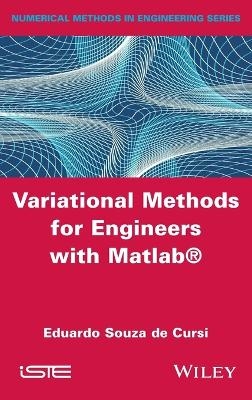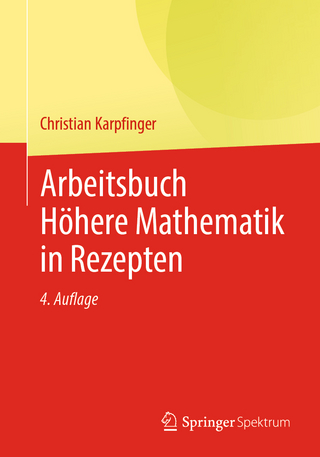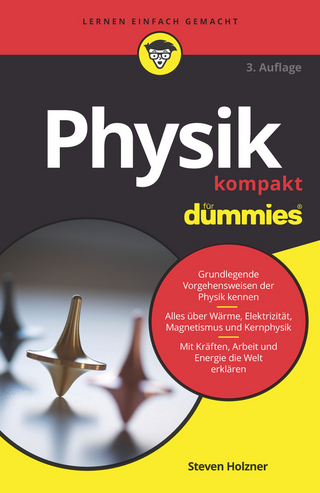
Variational Methods for Engineers with Matlab
ISTE Ltd and John Wiley & Sons Inc (Verlag)
978-1-84821-914-4 (ISBN)
The evolution of knowledge, of the engineering studies and of the society in general has led to a change of focus from students and researchers. New generations of students and researchers do not have the same relations to mathematics as the previous ones. In the particular case of variational methods, the presentations used in the past are not adapted to the previous knowledge, the language and the centers of interest of the new generations. Since these methods remain a core knowledge – thus essential - in many fields (Physics, Engineering, Applied Mathematics, Economics, Image analysis ...), a new presentation is necessary in order to address variational methods to the actual context.
Eduardo Souza de Cursi, Professor (INSA-Rouen, France); Dean of International Affairs (INSA-Rouen, France); Director LOFIMS (INSA-Rouen, France).
Introduction xi
Chapter 1. Integrals 1
1.1. Riemann integrals 3
1.2. Lebesgue integrals 6
1.3. Matlab® classes for a Riemann integral by trapezoidal integration 10
1.4. Matlab® classes for Lebesgue’s integral 17
1.5. Matlab® classes for evaluation of the integrals when is defined by a subprogram 33
1.6. Matlab® classes for partitions including the evaluation of the integrals 38
Chapter 2. Variational Methods for Algebraic Equations 51
2.1. Linear systems 52
2.2. Algebraic equations depending upon a parameter 62
2.2.1. Approximation of the solution by collocation 63
2.2.2. Variational approximation of the solution 65
2.2.3. Linear equations 66
2.2.4. Connection to orthogonal projections 67
2.2.5. Numerical determination of the orthogonal projections 69
2.2.6. Matlab® classes for a numerical solution 70
2.3. Exercises 98
Chapter 3. Hilbert Spaces for Engineers 103
3.1. Vector spaces 107
3.2. Distance, norm and scalar product 109
3.2.1. Distance 110
3.2.2. Norm 111
3.2.3. Scalar product 112
3.2.4. Cartesian products of vector spaces 117
3.2.5. A Matlab® class for scalar products and norms 118
3.2.6. A Matlab® class for Gram–Schmidt orthonormalization 125
3.3. Continuous maps 132
3.4. Sequences and convergence 134
3.4.1. Sequences 134
3.4.2. Convergence (or strong convergence) 134
3.4.3. Weak convergence 138
3.4.4. Compactness 139
3.5. Hilbert spaces and completeness 141
3.5.1. Fixed points 142
3.6. Open and closed sets 144
3.6.1. Closure of a set 144
3.6.2. Open and closed sets 145
3.6.3. Dense subspaces 146
3.7. Orthogonal projection 147
3.7.1. Orthogonal projection on a subspace 147
3.7.2. Orthogonal projection on a convex subset 150
3.7.3. Orthogonal projection on an affine subspace 151
3.7.4. Matlab® determination of orthogonal projections 153
3.8. Series and separable spaces 157
3.8.1. Series 158
3.8.2. Separable spaces and Fourier series 159
3.9. Duality 161
3.9.1. Linear functionals 161
3.9.2. Kernel of a linear functional 164
3.9.3. Riesz’s theorem 166
3.10. Generating a Hilbert basis 167
3.10.1. 1D situations 168
3.10.2. 2D situations 169
3.10.3. 3D situations 172
3.10.4. Using a sequence of finite families 175
3.11. Exercises 175
Chapter 4. Functional Spaces for Engineers 185
4.1. The L2 () space 186
4.2. Weak derivatives 189
4.2.1. Second-order weak derivatives 191
4.2.2. Gradient, divergence, Laplacian 192
4.2.3. Higher-order weak derivatives 195
4.2.4. Matlab® determination of weak derivatives 195
4.3. Sobolev spaces 199
4.3.1. Point values 201
4.4. Variational equations involving elements of a functional space 203
4.5. Reducing multiple indexes to a single one 205
4.6. Existence and uniqueness of the solution of a variational equation 207
4.7. Linear variational equations in separable spaces 210
4.8. Parametric variational equations 211
4.9. A Matlab® class for variational equations 213
4.10. Exercises 216
Chapter 5. Variational Methods for Differential Equations 221
5.1. A simple situation: the oscillator with one degree of freedom 224
5.1.1. Newton’s equation of motion 225
5.1.2. Boundary value problem and initial condition problem 226
5.1.3. Generating a variational formulation 226
5.1.4. Generating an approximation of a variational equation 230
5.1.5. Application to the first variational formulation of the BVP 230
5.1.6. Application to the second variational formulation of the BVP 231
5.1.7. Application to the first variational formulation of the ICP 232
5.1.8. Application to the second variational formulation of the ICP 232
5.2. Connection between differential equations and variational equations 233
5.2.1. From a variational equation to a differential equation 233
5.2.2. From a differential equation to a variational equation 236
5.3. Variational approximation of differential equations 243
5.4. Evolution partial differential equations 253
5.4.1. Linear equations 253
5.4.2. Nonlinear equations 255
5.4.3. Motion equations 256
5.4.4. Motion of a bar 264
5.4.5. Motion of a beam under flexion 268
5.5. Exercises 272
Chapter 6. Dirac’s Delta 279
6.1. A simple example 283
6.2. Functional definition of Dirac’s delta 285
6.2.1. Compact support functions 285
6.2.2. Infinitely differentiable functions having a compact support 286
6.2.3. Formal definition of Dirac’s delta 287
6.2.4. Dirac’s delta as a probability 287
6.3. Approximations of Dirac’s delta 288
6.4. Smoothed particle approximations of Dirac’s delta 289
6.5. Derivation using Dirac’s delta approximations 291
6.6. A Matlab® class for smoothed particle approximations 292
6.7. Green’s functions 298
6.7.1. Adjoint operators 299
6.7.2. Green’s functions 301
6.7.3. Using fundamental solutions to solve differential equations 302
Chapter 7. Functionals and Calculus of Variations 319
7.1. Differentials 320
7.2. Gâteaux derivatives of functionals 321
7.3. Convex functionals 324
7.4. Standard methods for the determination of Gâteaux derivatives 326
7.4.1. Methods for practical calculation 326
7.4.2. Gâteaux derivatives and equations of the motion of a system 329
7.4.3. Gâteaux derivatives of Lagrangians 332
7.4.4. Gâteaux derivatives of fields 333
7.5. Numerical evaluation and use of Gâteaux differentials 334
7.5.1. Numerical evaluation of a functional 335
7.5.2. Determination of a Gâteaux derivative 336
7.5.3. Determination of the derivatives with respect to the Hilbertian coefficients 339
7.5.4. Solving an equation involving the Gâteaux differential 343
7.5.5. Determining an optimal point 345
7.6. Minimum of the energy 347
7.7. Lagrange’s multipliers 349
7.8. Primal and dual problems 352
7.9. Matlab® determination of minimum energy solutions 354
7.10. First-order control problems 366
7.11. Second-order control problems 371
7.12. A variational approach for multiobjective optimization 374
7.13. Matlab® implementation of the variational approach for biobjective optimization 384
7.14. Exercises 388
Bibliography 393
Index 411
| Erscheinungsdatum | 11.10.2015 |
|---|---|
| Verlagsort | London |
| Sprache | englisch |
| Maße | 165 x 241 mm |
| Gewicht | 780 g |
| Themenwelt | Mathematik / Informatik ► Mathematik ► Algebra |
| Mathematik / Informatik ► Mathematik ► Angewandte Mathematik | |
| ISBN-10 | 1-84821-914-8 / 1848219148 |
| ISBN-13 | 978-1-84821-914-4 / 9781848219144 |
| Zustand | Neuware |
| Informationen gemäß Produktsicherheitsverordnung (GPSR) | |
| Haben Sie eine Frage zum Produkt? |
aus dem Bereich


